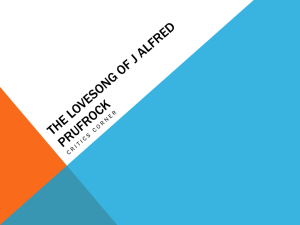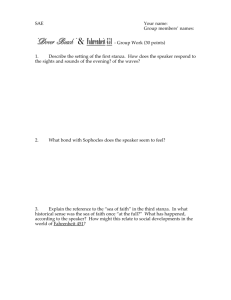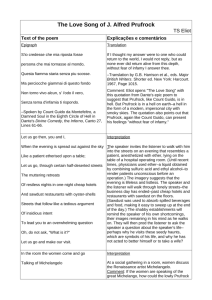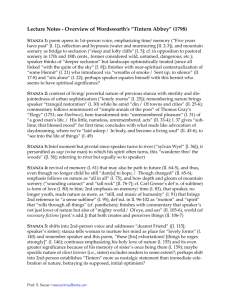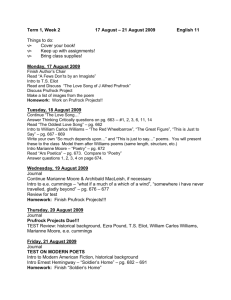The Love Song of J. Alfred Prufrock
advertisement
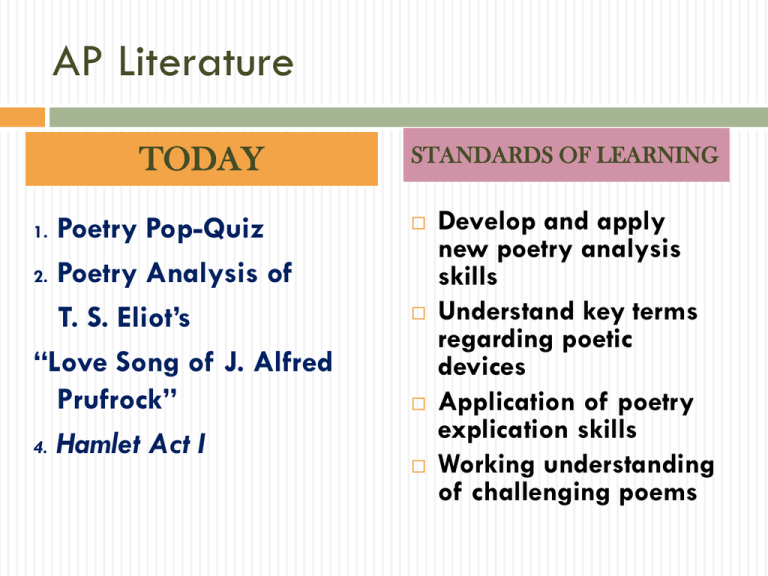
AP Literature TODAY Poetry Pop-Quiz 2. Poetry Analysis of T. S. Eliot’s “Love Song of J. Alfred Prufrock” 4. Hamlet Act I 1. STANDARDS OF LEARNING Develop and apply new poetry analysis skills Understand key terms regarding poetic devices Application of poetry explication skills Working understanding of challenging poems AP Literature TODAY Poetry Explication #1 2. Poetry Pop-Quiz 3. Poetry Explication #2 4. Poetry Analysis of T. S. Eliot’s “Love Song of J. Alfred Prufrock” 1. STANDARDS OF LEARNING Develop and apply new poetry analysis skills Understand key terms regarding poetic devices Application of poetry explication skills Working understanding of challenging poems AP Literature TODAY Poetry Pop-Quiz 2. Poetry Analysis of T. S. Eliot’s 3. “Hamlet” Homework: “Love Song of J. Alfred Prufrock” 1. Essay STANDARDS OF LEARNING Develop and apply new poetry analysis skills Understand key terms regarding poetic devices Application of poetry explication skills Working understanding of challenging poems “THE LOVE SONG OF J. ALFRED PRUFROCK” A DEEPER LOOK INTO THE MEANING AND FORM Source: Cummings Study Guides and University of Michigan Context: Modernism Planes, subway trains, cars, and WWI created dramatic shifts in day to day modern life that often left people feeling lost or left behind, questioning their identity. Modernist poetry is often difficult to understand and analyze because the SPEAKER is usually uncertain about his/her own ontological (the essence/nature) being. The speaker in modernist poems characteristically wrestles with the fundamental question of “self,” often feeling fragmented and alienated from the world around him/her. In other words, a coherent speaker with a clear sense of himself/herself is hard to find in modernist poetry, often leaving the reader feeling “lost.” Biographical Context Born in St. Louis on Sept. 26, 1888. Lived there for 18 years Attended Harvard and earned his undergraduate (bachelor’s) and master’s degrees there. Went to Paris for a year; returned to Harvard to pursue a doctorate in philosophy, but ended up settling in England in 1914 (24 yr.) He published his poems, including this one, in magazines in 1915. He was known for his articulation of the disillusionment (loss of identity) of a younger post-WWI generation with the values and conventions of the Victorian era. He received the Novel Prize for Literature in 1948 and died in London in 1965. Elements of the Poem Type of Work: Dramatic Monologue (Modern) A dramatic monologue presents a moment in which a speaker discusses a topic and, in doing so, reveals his/her personal feelings to a listener (reader). Only the speaker talks, and intentionally and unintentionally reveals information about himself/herself. Since the main focus of a dramatic monologue is this personal information, and not the speaker’s topic, a dramatic monologue is a type of character study. The Speaker The poem centers on a balding, insecure middle-aged man. He expresses his thoughts about the dull, uneventful, mediocre life he leads as a result of his feelings of inadequacy and his fear of making decisions. Unable to seize opportunities or take risks (especially with women), he lives in a world that is the same today as it was yesterday and will be the same tomorrow as it is today. He does try to make progress, but his timidity and fear of failure inhibit him from taking action. The Setting The action takes place in the evening in a bleak section of a smoky/foggy city. This city is probably St. Louis, where Eliot grew up, but could also be London, where he moved to. Eliot probably intended to leave the setting ambiguous because it was unimportant and could be any city anywhere. The Characters J. Alfred Prufrock: The speaker, a timid, overcautious middle-aged main. He escorts his listener through streets in a shabby part of a city, past cheap hotels and restaurants, to a social gathering where the women he would like to meet are conversing. However, he is hesitant to take part in the activity for fear of making a fool of himself. The Characters The Listener: An unidentified companion of Prufrock. The listener could also be Prufrock’s inner self, one that prods him but fails to move him to action. The Characters The Women: Women at a social gathering that Prufrock would like to meet, but worries that they will look down on him or reject him. The Characters The Lonely Men in Shirtsleeves: Leaning out of the windows and smoking pipes, they are like Prufrock in that they look upon a scene without being a part of it. The smoke from their pipes helps form the haze over the city that serves as a metaphor for a timid cat (which could very well be Prufrock himself). The Themes Loneliness and Alienation: Prufrock is a pathetic man whose anxieties and obsessions have isolated him. Indecision: Prufrock resists making decisions for fear that their outcomes will turn out wrong. Inadequacy: Prufrock continually worries that he will make a fool of himself and that people will ridicule him for his clothes, his bald spot, and his overall physical appearance. Pessimism: Prufrock sees only the negative side of his own life and the lives of others. Style Conversational diction combined with the stylized language of poetry (figurative language). Variations in length and meter Constant shifts in the train of thought Shifts in topics under discussion Shifts from abstract to concrete (universal to particular) Shifts from obvious allusions to more abstract allusions (suggesting Prufrock was well read and retained bits and pieces of what he read in his memory) No need to take notes from here Stanza 1 The speaker invites the listener to walk with him into the streets on an evening that resembles a patient, anesthetized with ether, lying on the table of a hospital operating room. The imagery suggests that the evening is lifeless and listless. The speaker and listener walk through lonely streets, after the day has ended, past cheap hotels and restaurants with sawdust on the floors (that soak up spilled food and drink to make it easier to clean at the end of the night). Stanza 1 The shabby surroundings remind the speaker of his own shortcomings, their images remaining in his mind as he walks on. Prufrock then prods the listener to ask the speaker a question about the speaker’s life—perhaps why he visits these seedy places, which are symbols of his life, and why he has not acted to better himself. Stanza 2 In the room the women come and go Talking of Michelangelo. At a social gathering now in a room, women discuss the great Renaissance artist. Prufrock may wonder how they would possibly be interested in him when they are discussing someone as impressive as Michelangelo. Stanza 3: Symbolism “cat” Smoky haze spreads across the city. The haze is like a quiet, timid cat, padding around, rubbing its head on objects, licking its tongue, and curling up to sleep after allowing soot to fall upon it. The speaker resembles this cat as he looks into windows or into “the room,” trying to decide whether to enter and become part of the activity. Eventually, he curls up in the safety and security of his own soft arms, alone, separate. What this may mean is that Prufrock feels inferior and is unable to act decisively. He limits himself to corners, as a timid person might do at a dance; and stands stagnant, becoming the target of ridicule or judgment (the soot). Stanza 4 The speaker tells himself there is no hurry. There will be a time to decide, then act, then put on the right face to meet people. He also mentions that there will be time to kill and time to act, and even time to do many things. There is also mention of the time to THINK about doing things, to dream and then revise those dreams, all BEFORE sitting down with a woman to take “toast and tea.” This is the speaker’s way of postponing and avoiding his fear of failure. He says that there will always be time to face it, so why face it now. Stanza 5 The repetition of the coming and going of the women in the room suggest that life is repetitive and dull, and this feeling of rejection and loneliness is also repeated. Stanza 6 Prufrock says that there will be time to wonder whether he dares to approach a woman. He feels like turning back. After all, he has a bald spot, thinning hair, and thin arms and legs; he even doubts the acceptability of his clothing before questioning what people will think of him, particularly the women. He decides to think about it and make a decision, then reverse that decision. Stanza 7 Prufrock realizes that the people here are the same as the people he has met many times before—the same, uninteresting people in the same uninteresting world. They even all sound the same, so why should he do anything? The speaker is trying to justify his reasoning for backing out and being indecisive. Stanza 8 The speaker mentions how he has also seen their gazes before, many times—gazes that form an opinion of him, treating him like an insect pinned into a display. He questions how he will be able to explain himself to them—the ordinariness, the mediocrity of his life. Stanza 9 Through a continuation of this parallel structure, the speaker mentions that he has known women like these before, wearing jewelry but really bare, lacking substance. He wonders why he is even thinking about them and blames it on the smell of perfume. Stanza 10 He asks if he will tell a woman that he came through narrow streets, where lonely men (like himself) lean out of windows watching life go by without taking part in it. He mentions that he should have been nothing more than crab claws in the depths of the silent oceans. This imagery of a crab may also mean that he is similar to them because he is always moving side to side, and never up or down. He may also consider himself a bottom feeder. Stanza 11 We see that the time passes peacefully, as if the afternoon/evening is sleeping or wasting time, stretched out on the floor. He wonders if he should sit down with someone, take a chance to make an acquaintance, or simply live. He then laments about how he has suffered and even imagined his head being brought in on a platter (allusion to John the Baptist). He even finds it difficult to compare himself to this character because he is no prophet and has seen many opportunities pass and has seen death up close, holding his coat, snickering. In short, he has been afraid of life and death both. Stanza 12 He asks if it would have been worth it all along to try to make a connection with one of the women (rambling, questioning his indecision). He wonders if it would be worth it to act on this urge for belonging and fitting in if he knows that he will only have her criticize and reject him (again, seeing only the pessimistic, worst-case-scenario). Stanza 13 He again questions if it would have been worth it to have a woman to experience sunset, or after all the mornings or evenings when the workmen walk the streets, or discussing novels over tea, after hearing the drag of a skirt across the floor or plumping a pillow or throwing off a shawl before being told at the end of the night that he was mistaken about her intentions toward him. Stanza 14 Here the speaker compares himself to Hamlet, whose tragic flaw is indecisiveness. He has trouble with this comparison and rather aligns himself with the attendant lord (Polonius) who is seen as a long-winded fool. Notice the capitalization of “Fool” which also alludes to a court jester, or Yorick (whose skull Hamlet holds). Stanzas 15-19 The speaker now realizes that time is passing and he continues to grow old. Like other men going through a mid-life crisis, he considers changing his hairstyle and clothing. He also hears the song of the sirens (like Odysseus in the Odyssey), but says that not even they would waste the time to sing to him.
